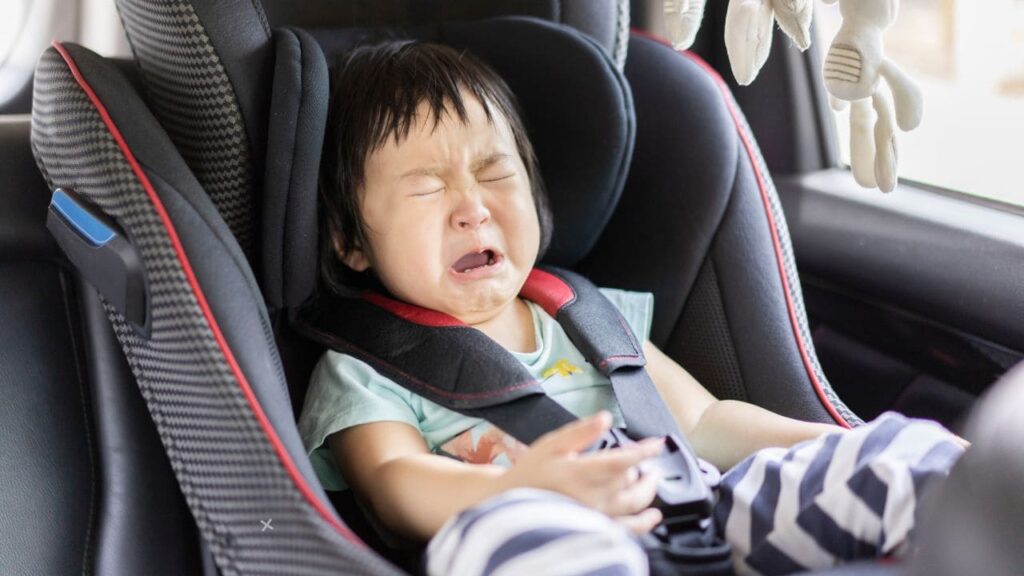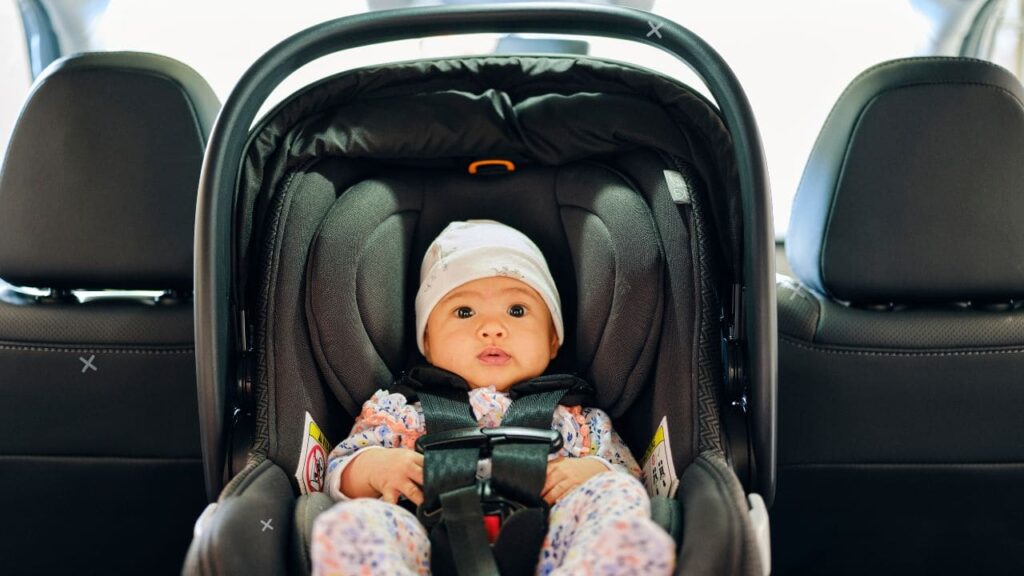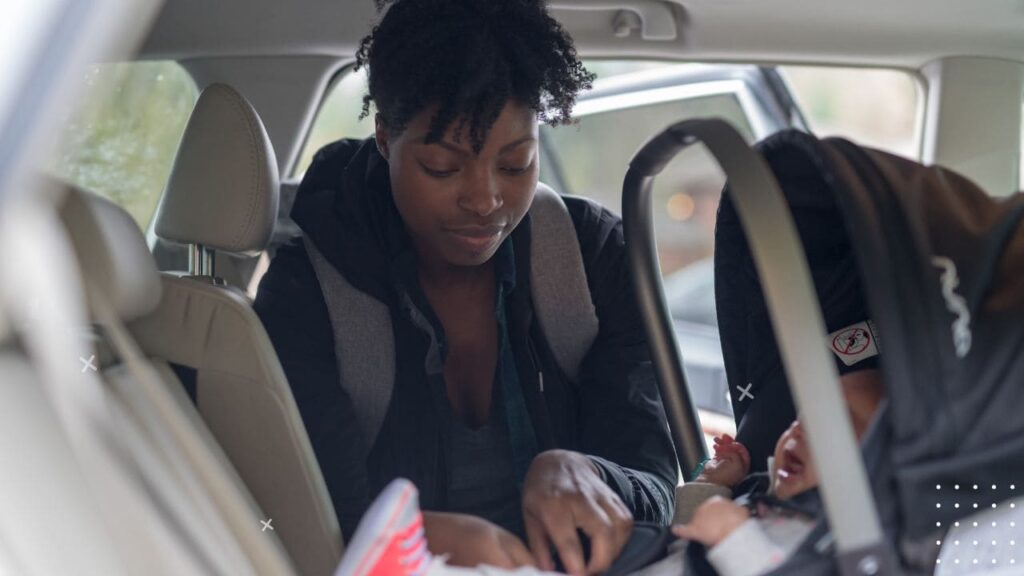Imagine this: You’ve finally gotten your little one settled into their car seat, and you’re ready to embark on a much-needed family outing. But as soon as you pull out of the driveway, the wailing begins. Suddenly, those peaceful visions of a smooth car ride are shattered by the heart-wrenching cries of your distressed baby. It’s a situation that strikes fear into the hearts of even the most seasoned parents.
Babies crying in the car is a universal experience, and it can leave you feeling helpless and overwhelmed. But fear not, dear parents! We’ve got your back with a comprehensive guide to understanding and soothing your little one’s tears on the road.

Understanding the Reasons Behind a Baby’s Cries in the Car
Before we dive into solutions, let’s first explore the potential causes behind a baby’s distress in the car. By understanding the “why” behind those cries, you’ll be better equipped to address the issue at its source.
- Discomfort: The car seat, while designed for safety, can sometimes feel confining or uncomfortable for babies, especially during long stretches. Factors like improper positioning, tight straps, or even the material of the seat itself can contribute to discomfort.
- Overstimulation: The constant motion, vibrations, and unfamiliar sights and sounds of the car can be overwhelming for a baby’s developing senses. This sensory overload can lead to fussiness and crying.
- Change in Routine: Babies thrive on consistency and predictability. A car ride disrupts their normal routine, which can be unsettling and cause distress.
- Separation Anxiety: For some babies, being separated from their primary caregiver and placed in a car seat can trigger separation anxiety, leading to tears.
- Physical Needs: Sometimes, a baby’s cries may simply be a sign of hunger, thirst, or a need for a diaper change.
Next-step advice: Before embarking on a car journey, try to address any potential sources of discomfort or overstimulation. Ensure your baby is well-fed, hydrated, and has a fresh diaper. Also, consider introducing them to the car seat gradually, allowing them to get comfortable with the new environment.
| Common Causes | Potential Solutions |
|---|---|
| Discomfort (tight straps, improper positioning) | Adjust car seat, use padding or positioners |
| Overstimulation (motion, vibrations, new sights/sounds) | Play soothing music, use window shades, limit visual stimuli |
| Change in Routine | Gradually introduce car rides, maintain consistent routines |
| Separation Anxiety | Use comfort items, mirrors to see parents, frequent reassurance |
| Physical Needs (hunger, thirst, soiled diaper) | Feed, hydrate, and change baby before car rides |
The Science Behind Car-Related Crying
While the reasons behind a baby’s car-related crying may seem straightforward, there’s actually some fascinating science at play. Understanding the underlying mechanisms can help us better address and soothe our little ones’ distress.
One of the primary contributors to car-related crying is a phenomenon known as vestibular overstimulation. The vestibular system, located in the inner ear, is responsible for maintaining balance and spatial awareness. The constant motion and vibrations experienced in a moving car can overwhelm this delicate system, leading to discomfort, dizziness, and, ultimately, tears.
Additionally, the unfamiliar sights and sounds of the car environment can trigger a stress response in babies. Their developing brains perceive these new stimuli as potential threats, prompting the release of cortisol, the body’s primary stress hormone. This physiological response can manifest as fussiness, crying, and even physical symptoms like increased heart rate and elevated blood pressure.
Interestingly, research has also linked car-related crying to a baby’s developing sense of object permanence – the understanding that objects continue to exist even when they’re out of sight. When separated from their primary caregivers and placed in a car seat, some babies may experience separation anxiety and distress, as they struggle to comprehend that their loved ones still exist, even though they can’t see them.
By understanding these underlying physiological and psychological factors, we can better tailor our soothing strategies to address the root causes of our little ones’ distress.
9 Heartwarming Solutions to Calm a Crying Baby in the Car
Now that we’ve explored the reasons behind those tears, let’s dive into our arsenal of soothing solutions. These tried-and-true techniques have been lifesavers for countless parents navigating the challenges of a crying baby in the car.
1. Pacifiers and Comfort Items
Pacifiers and familiar comfort items, such as a favorite blanket or stuffed animal, can work wonders in calming a distressed baby. These familiar objects provide a sense of security and familiarity, helping your little one feel more relaxed and at ease in the unfamiliar car environment.
Next-step advice: Keep a stash of pacifiers and comfort items within easy reach in the car. Rotate them regularly to ensure your baby doesn’t become overly attached to a single item, which could lead to meltdowns if it’s misplaced.
2. White Noise and Soothing Music
The constant hum of the car’s engine, coupled with external noises from the road, can be overwhelming for a baby’s sensitive ears. Combat this by playing calming white noise or gentle lullabies through your car’s audio system. These soothing sounds can help mask external noises and create a peaceful, familiar environment for your little one.
Next-step advice: Experiment with different types of white noise or lullaby playlists to find the ones that work best for your baby. Consider investing in a portable white noise machine specifically designed for car use.
3. Distraction Techniques
Sometimes, the best way to soothe a crying baby is to redirect their attention. Keep a stash of engaging toys, books, or even colorful scarves within reach. These distraction techniques can help captivate your baby’s interest and shift their focus away from the discomfort or overstimulation that may be causing their tears.
Next-step advice: Rotate your distraction tools regularly to keep your baby’s interest piqued. Consider safe, mirror-based toys that allow your little one to see their own reflection, which can be endlessly fascinating for babies.
| Age Range | Suggested Distraction Tools |
|---|---|
| 0-3 months | Unbreakable mirrors, soft books, rattles |
| 3-6 months | Textured toys, stuffed animals, musical instruments |
| 6-12 months | Board books, peek-a-boo toys, sensory balls |
| 12-24 months | Shape sorters, stacking cups, sing-along books |
4. Temperature and Comfort Adjustments
Ensuring your baby’s comfort is paramount when it comes to preventing or soothing car-related tears. Pay close attention to the car’s temperature and adjust it accordingly. Additionally, consider adjusting your baby’s clothing or seating position to alleviate any potential sources of discomfort.
Next-step advice: Dress your baby in layers, so you can easily add or remove clothing as needed to maintain a comfortable temperature. Invest in a high-quality, well-padded car seat that provides ample support and cushioning for your little one.
5. Frequent Breaks and Stretching
For longer car rides, it’s essential to give your baby a chance to stretch and move around. Prolonged periods of confinement in a car seat can lead to restlessness and discomfort, which can trigger crying fits. Plan for frequent stops along the way, allowing your little one to move freely and release any pent-up energy.
Next-step advice: Research your route ahead of time and identify safe, convenient locations for breaks. Pack a portable changing pad and a few toys or books to make these pit stops more enjoyable for your baby.
6. Mirroring and Reassurance
Sometimes, the most effective solution is the simplest one: your presence and reassurance. Maintain eye contact with your baby through the rearview mirror, speaking in a soothing voice and offering gentle reassurance. This can help strengthen the parent-child bond and provide comfort during those fussy moments.
Next-step advice: Consider investing in a backseat mirror specifically designed for this purpose, so your baby can see your face more easily. Practice deep breathing exercises to stay calm and project a sense of serenity, even when your baby’s cries are at their peak.
7. Snacks and Hydration
It’s easy to overlook basic needs like hunger and thirst when dealing with a crying baby in the car. However, these simple factors can often be the root cause of fussiness. Offer age-appropriate snacks or beverages during your journey to ensure your little one’s needs are met.
Next-step advice: Pack a cooler with your baby’s favorite finger foods and beverages, and plan to offer them at regular intervals during your car ride. Consider investing in spill-proof snack containers and sippy cups designed for use in the car.
8. Adjusting the Car Environment
While you can’t control every aspect of your car’s environment, there are a few simple tweaks you can make to create a more comfortable and calming space for your baby. Dimming the lights or opening a window for fresh air can help alleviate overstimulation or stuffiness. Additionally, adjusting your baby’s seating position or the angle of their car seat can provide relief from discomfort.
Next-step advice: Experiment with different lighting levels, airflow, and seating arrangements to find the combination that works best for your baby. Consider investing in car window shades or tinted windows to reduce glare and harsh sunlight.
| Adjustment | Purpose |
|---|---|
| Dim Lights | Reduce overstimulation, create a calming atmosphere |
| Open Windows | Provide fresh air circulation, alleviate stuffiness |
| Adjust Seating Position | Improve comfort, reduce strain on baby’s body |
| Use Window Shades | Block harsh sunlight, minimize distractions |
| Adjust Temperature | Maintain a comfortable, temperate environment |
9. Seeking Professional Assistance
If your baby’s crying persists despite trying various soothing techniques, it may be time to seek guidance from a professional. Your pediatrician or a child development specialist can help identify and address any underlying issues that may be contributing to your little one’s distress in the car.
Next-step advice: Keep a detailed log of your baby’s crying episodes, noting any potential triggers or patterns. This information can be invaluable for your healthcare provider in determining the best course of action.

The Power of Positive Reinforcement
While implementing soothing techniques is crucial, it’s equally important to reinforce and encourage positive behaviors from your little one. Positive reinforcement can go a long way in helping your baby associate car rides with pleasant experiences, ultimately reducing the likelihood of future tears and tantrums.
Here are some simple yet effective positive reinforcement strategies you can incorporate during your journeys:
A. Praise and Encouragement: Whenever your baby remains calm or exhibits desirable behavior in the car, shower them with verbal praise and encouragement. Words like “Good job!” or “You’re doing so well!” can reinforce the positive association and motivate them to continue the desired behavior.
B. Reward System: Consider implementing a simple reward system, such as offering a special toy or treat when your baby remains calm throughout the car ride. This positive reinforcement can help shape their behavior and create a positive association with car journeys.
C. Celebratory Moments: When you reach your destination without any major crying episodes, make a big deal out of it! Engage your baby in a celebratory song, dance, or special activity to reinforce the idea that calm car rides are rewarding and enjoyable experiences.
D. Consistency is Key: Positive reinforcement is most effective when applied consistently. Make sure to reinforce desirable behaviors every time they occur, and involve all caregivers in the process to ensure a unified approach.
Remember, positive reinforcement isn’t just about rewarding good behavior; it’s also about creating a nurturing environment where your baby feels supported, encouraged, and celebrated for their efforts. By incorporating these simple strategies, you’ll not only help soothe fussy moments in the present but also lay the foundation for more peaceful car rides in the future.
Preparing for a Tear-Free Journey
While having a well-stocked arsenal of soothing techniques is essential, proper preparation can go a long way in preventing or minimizing car-related crying episodes. Here are some proactive steps you can take to set yourself and your little one up for success:
A. Gradual Exposure: Before embarking on a long car journey, introduce your baby to the car seat and car environment gradually. Allow them to sit in the car seat while stationary, engaging them with toys and praise for remaining calm. This gradual exposure can help them become more comfortable and accustomed to the new surroundings.
B. Timing is Key: Pay attention to your baby’s natural rhythms and schedule car rides accordingly. Avoiding long journeys during times when your little one is typically fussy, such as when they’re hungry or tired, can help minimize the likelihood of a meltdown.
C. Pack a Soothing Essentials Bag: Assemble a dedicated bag or container with all the soothing essentials you might need during a car ride. This could include pacifiers, comfort items, snacks, beverages, and a variety of engaging toys or books to help distract and entertain your baby.
| Category | Items |
|---|---|
| Comfort Items | Pacifiers, blankets, stuffed animals |
| Snacks and Beverages | Age-appropriate finger foods, water, milk/formula |
| Entertainment | Books, toys, music/white noise player |
| Hygiene | Diapers, wipes, changing pad |
| Extras | Extra clothing, burp cloths, plastic bags (for soiled items) |
D. Plan Your Route: Before setting out, research your route and identify potential stopping points where you can safely pull over and take a break if needed. Having a plan in place can help alleviate stress and ensure you’re prepared for any eventuality.
E. Enlist a Co-Pilot: If possible, have a trusted co-parent, family member, or friend accompany you on longer car rides. Having an extra set of hands and a supportive presence can make a world of difference when dealing with a fussy baby.
By taking these proactive steps, you’ll not only increase your chances of a tear-free journey but also ensure that you’re well-equipped to handle any fussy moments that may arise along the way.

Tips for Staying Calm and Reducing Stress
Dealing with a crying baby in the car can be emotionally and physically draining for parents. It’s essential to have strategies in place to help you remain calm and manage stress effectively during these challenging moments.
- Practice Deep Breathing: When your baby’s cries start to escalate, take a few deep breaths and remind yourself that this is a temporary phase. Staying calm and composed can often have a soothing effect on your little one.
- Take Breaks: If your baby’s crying becomes overwhelming, pull over in a safe location and take a break. Step out of the car, stretch your legs, and give yourself a few moments to reset before continuing your journey.
- Enlist Support: If possible, have a co-parent or trusted friend accompany you on longer car rides. Having an extra set of hands and a supportive presence can make a world of difference when dealing with a fussy baby.
- Reframe Your Mindset: Instead of viewing your baby’s cries as a personal failure or a source of frustration, try to approach the situation with empathy and understanding. Your little one is communicating their needs in the only way they know how, and it’s your job to respond with patience and compassion.
- Celebrate Small Victories: Even if your baby’s crying doesn’t completely subside, take pride in the moments when you’re able to provide comfort or distraction. Every small victory is a step in the right direction.
Remember, dealing with a crying baby in the car is a universal experience, and it’s perfectly normal to feel overwhelmed at times. Be kind to yourself, and know that this phase, too, shall pass.
Conclusion
Navigating a crying baby in the car can be one of the most challenging and emotionally taxing experiences for new parents. But with the right tools and strategies in your arsenal, you can transform those tearful journeys into peaceful, enjoyable rides.
Remember, every baby is unique, and what works for one may not work for another. Approach each situation with patience, empathy, and a willingness to try new techniques. Celebrate the small victories, and know that this phase, like so many others, is temporary.
Most importantly, don’t forget to take care of yourself. Parenting is a marathon, not a sprint, and prioritizing your own well-being is crucial for maintaining the resilience and positivity needed to support your little one through every stage of their development.
So, fellow parents, keep your chin up, your car stocked with soothing essentials, and your heart open to the beautiful journey ahead. With a little creativity, a lot of love, and a whole lot of determination, you’ll navigate those fussy moments with grace and emerge stronger and more confident on the other side.
FAQ – My Baby Cries Hysterically in the Car
Is it safe to take my baby out of the car seat while driving?
Absolutely not. For your baby’s safety, it’s crucial to keep them securely fastened in their car seat at all times while the vehicle is in motion.
Can I use medication or supplements to calm my crying baby in the car?
It’s best to consult with your pediatrician before administering any medication or supplements to your baby. Many over-the-counter products can have unintended side effects or interactions, and your doctor can provide guidance on safe and effective options.
What if my baby’s crying is accompanied by other concerning symptoms?
If your baby’s crying is accompanied by symptoms such as fever, rash, or lethargy, it’s important to seek medical attention promptly. These could be signs of an underlying illness or condition that requires professional care.
How long does the “crying in the car” phase typically last?
Every baby is different, but many parents report that the intense crying phase tends to subside around 6-9 months of age, as babies become more accustomed to car rides and their developing senses adapt to the stimuli.
Can I use noise-canceling headphones to block out my baby’s cries while driving?
While noise-canceling headphones can provide temporary relief, it’s important to remain fully aware of your baby’s cries and needs while driving. Instead, consider playing soothing music or white noise through your car’s audio system, which can help mask the crying without compromising your ability to hear and respond to your little one.












